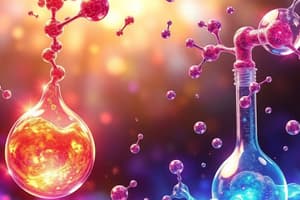Podcast
Questions and Answers
What is a synthesis reaction?
What is a synthesis reaction?
A reaction in which two or more reactants combine to produce one complex product.
The basic formula for a synthesis reaction is: A + B → _____
The basic formula for a synthesis reaction is: A + B → _____
AB
Synthesis reactions always result in exactly one product.
Synthesis reactions always result in exactly one product.
True (A)
What type of compound is typically formed in a synthesis reaction between a metal and a non-metal?
What type of compound is typically formed in a synthesis reaction between a metal and a non-metal?
What type of compound is typically formed in a synthesis reaction between two non-metals?
What type of compound is typically formed in a synthesis reaction between two non-metals?
Write the balanced chemical equation for the synthesis reaction between sodium (Na) and chlorine ($Cl_2$).
Write the balanced chemical equation for the synthesis reaction between sodium (Na) and chlorine ($Cl_2$).
It is always straightforward to predict the product of any synthesis reaction.
It is always straightforward to predict the product of any synthesis reaction.
How is the chemical formula for the product of a synthesis reaction between a metal and a non-metal predicted?
How is the chemical formula for the product of a synthesis reaction between a metal and a non-metal predicted?
Predict the product and write the balanced equation for the synthesis reaction between Magnesium ($Mg$) and Chlorine ($Cl_2$).
Predict the product and write the balanced equation for the synthesis reaction between Magnesium ($Mg$) and Chlorine ($Cl_2$).
When predicting the product of a synthesis reaction involving hydrogen, hydrogen usually acts as a metal.
When predicting the product of a synthesis reaction involving hydrogen, hydrogen usually acts as a metal.
Write the balanced chemical equation for the synthesis reaction between hydrogen gas ($H_2$) and chlorine gas ($Cl_2$).
Write the balanced chemical equation for the synthesis reaction between hydrogen gas ($H_2$) and chlorine gas ($Cl_2$).
Burning a substance using oxygen is an example of a synthesis reaction.
Burning a substance using oxygen is an example of a synthesis reaction.
Write the balanced chemical equation for the synthesis reaction when magnesium ($Mg$) burns in oxygen ($O_2$).
Write the balanced chemical equation for the synthesis reaction when magnesium ($Mg$) burns in oxygen ($O_2$).
What type of compound is formed when a metal oxide combines with water in a synthesis reaction?
What type of compound is formed when a metal oxide combines with water in a synthesis reaction?
Complete and balance the following synthesis reaction: $K_2O(s) + H_2O(l) \rightarrow$ ?
Complete and balance the following synthesis reaction: $K_2O(s) + H_2O(l) \rightarrow$ ?
Complete and balance the following synthesis reaction: $H_2O(l) + CO_2(g) \rightarrow$ ?
Complete and balance the following synthesis reaction: $H_2O(l) + CO_2(g) \rightarrow$ ?
What is a decomposition reaction?
What is a decomposition reaction?
The basic formula for a decomposition reaction is: AB → _____ + _____
The basic formula for a decomposition reaction is: AB → _____ + _____
A decomposition reaction starts with only one reactant.
A decomposition reaction starts with only one reactant.
Write the balanced chemical equation for the decomposition of water ($H_2O$).
Write the balanced chemical equation for the decomposition of water ($H_2O$).
Decomposition reactions usually require energy input to occur.
Decomposition reactions usually require energy input to occur.
What are the typical products when a simple binary ionic compound undergoes decomposition?
What are the typical products when a simple binary ionic compound undergoes decomposition?
When a binary ionic compound decomposes, the non-metal product is always monatomic.
When a binary ionic compound decomposes, the non-metal product is always monatomic.
Write the balanced chemical equation for the decomposition of potassium chloride ($KCl$).
Write the balanced chemical equation for the decomposition of potassium chloride ($KCl$).
Flashcards
What is Synthesis?
What is Synthesis?
A reaction where two or more reactants combine to form one complex product.
What is Decomposition?
What is Decomposition?
A reaction where one larger complex molecule breaks down into two or more simpler products; the opposite of a synthesis reaction.
Element + Element -> Simple Binary Ionic Compound
Element + Element -> Simple Binary Ionic Compound
A synthesis reaction between a metal and non-metal to predicted an ionic compound.
Element + Element -> Synthesis Reactions involving Hydrogen
Element + Element -> Synthesis Reactions involving Hydrogen
Signup and view all the flashcards
Element + Element -> Burning using Oxygen
Element + Element -> Burning using Oxygen
Signup and view all the flashcards
Compound + Compound -> Metal oxides with water
Compound + Compound -> Metal oxides with water
Signup and view all the flashcards
Simple Binary Ionic Compound decomposition
Simple Binary Ionic Compound decomposition
Signup and view all the flashcards
Study Notes
Types of Reactions
- Synthesis and decomposition reactions are two types of chemical reactions.
Synthesis Reactions
- Involve two or more reactants combining to form one complex product.
- The basic formula is A + B → AB.
- Reactants can be elements or compounds.
- Only one product is produced
Synthesis Reaction Combinations:
- Element + Element results in a compound.
- Metal + non-metal yields an ionic compound.
- Non-metal + non-metal yields a covalent compound.
- Element + Compound results in a compound.
- Compound + Compound results in a compound.
Synthesis Reaction Examples
- Sodium and chlorine react to produce sodium chloride: 2 Na (s) + Cl₂ (g) → 2 NaCl (s).
- Carbon and chlorine react to produce carbon tetrachloride: C(s) + 2 Cl₂ (g) → CCl₄ (s).
- Ammonia and hydrogen chloride react to produce ammonium chloride: NH₃ (g) + HCl (g) → NH₄Cl (s).
Predicting Products of Synthesis Reactions
- Predicting the product can be difficult as reactant conditions play an important role.
- Predicting the product is possible in a few synthesis reactions.
Element + Element Reactions
- The chemical formula for a simple binary ionic compound between a metal and non-metal follows the rules for ionic compounds.
- Example reaction: Mg(s) + Cl₂(g) → MgCl₂(s)
- Hydrogen acts as a non-metal and forms molecular compounds.
- Apply the rules for ionic compounds, using a +1 charge for hydrogen (H⁺¹).
- Example reaction: H₂(g) + Cl₂(g) → 2 HCl(g)
- Burning using oxygen follows a synthesis reaction.
- Example reaction: 2 Mg(s) + O₂(g) → 2 MgO(s)
- The criss-cross method determines the formula for MgO: Mg has a charge of +2, O has a charge of -2, and the formula has been reduced from Mg₂O₂ to MgO.
Compound + Compound Reactions
- Metal oxides combine with water to form metal hydroxides.
- Example: K₂O(s) + H₂O(l) → KOH(s)
- Reactions involving molecular compounds: H₂O(l) + CO₂(g) → H₂CO₃(aq)
Decomposition Reactions
- Involve one larger complex molecule breaking down into two or more simpler products; it is the opposite of synthesis.
- The basic formula: AB → A + B
- The reaction is the reverse of synthesis.
- One reactant yields elements or compounds.
Decomposition Reaction Examples
- Decomposition of water: 2 H₂O (l) → 2 H₂ (g) + O₂ (g).
Predicting Products of Decomposition Reactions
- Decomposition reactions usually require energy.
- Predicting products is difficult and depends on reaction conditions, especially for molecular or ionic compounds containing polyatomic ions.
- Products are predictable in at least one decomposition reaction.
Simple Binary Ionic Compound Decomposition
- A simple binary ionic compound undergoes decomposition into a metal and a non-metal.
- The non-metal follows HOBrFINCl rules and exists as a diatomic molecule.
- Example: 2 KCl(l) → 2 K(s) + Cl₂(g)
Studying That Suits You
Use AI to generate personalized quizzes and flashcards to suit your learning preferences.




